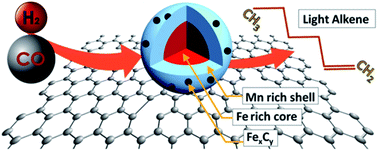Our official English website, www.x-mol.net, welcomes your
feedback! (Note: you will need to create a separate account there.)
Mn–Fe nanoparticles on a reduced graphene oxide catalyst for enhanced olefin production from syngas in a slurry reactor†
RSC Advances ( IF 3.9 ) Pub Date : 2018-04-19 00:00:00 , DOI: 10.1039/c8ra02193g Al-Hassan Nasser 1, 2, 3 , Lisheng Guo 3 , Hamada ELnaggar 1 , Yang Wang 3 , Xiaoyu Guo 3 , Ahmed AbdelMoneim 1 , Noritatsu Tsubaki 3
RSC Advances ( IF 3.9 ) Pub Date : 2018-04-19 00:00:00 , DOI: 10.1039/c8ra02193g Al-Hassan Nasser 1, 2, 3 , Lisheng Guo 3 , Hamada ELnaggar 1 , Yang Wang 3 , Xiaoyu Guo 3 , Ahmed AbdelMoneim 1 , Noritatsu Tsubaki 3
Affiliation

|
Fe nanoparticles (NPs) supported on reduced graphene oxide (rGO) nano-sheets were promoted with Mn and used for the production of light olefins in Fischer–Tropsch reactions carried out in a slurry bed reactor (SBR). The prepared catalysts were characterized by X-ray fluorescence (XRF), X-ray diffraction (XRD), transmission electron microscope (TEM), Raman spectroscopy, N2 physisorption, temperature programmed reduction (TPR) and X-ray photoelectron spectroscopic (XPS) methods. Mn was shown to preferentially migrate to the Fe NP surface, forming a Mn-rich shell encapsulating a core rich in Fe. The Mn shell regulated the diffusion of molecules to and from the catalyst core, and preserved the metallic Fe phase by lowering magnetite formation and carburization, so decreasing water gas shift reaction (WGSR) activity and CO conversion, respectively. Furthermore, the Mn shell reduced H2 adsorption and increased CO dissociative adsorption which enhanced olefin selectivity by limiting hydrogenation reactions. Modification of the Mn shell thickness regulated the catalytic activity and olefin selectivity. Simultaneously the weak metal–support interaction further increased the migration ability owing to the utilization of a graphene-based support. Space velocities, pressures and operating temperatures were also tested in the reactor to further enhance light olefin production. A balanced Mn shell thickness produced with a Mn concentration of 16 mol Mn/100 mol Fe was found to give a good olefin yield of 19% with an olefin/paraffin (O/P) ratio of 0.77. Higher Mn concentrations shielded the active sites and reduced the conversion dramatically, causing a fall in olefin production. The optimum operating conditions were found to be 300 °C, 2 MPa and 4.2 L g−1 h−1 of 1 : 1 H2 : CO syngas flow; these gave the olefin yield of 19%.
中文翻译:

还原氧化石墨烯催化剂上的 Mn-Fe 纳米颗粒用于提高浆态反应器中合成气的烯烃产量†
负载在还原氧化石墨烯 (rGO) 纳米片上的铁纳米颗粒 (NPs) 用 Mn 促进,并用于在浆态床反应器 (SBR) 中进行的费托反应中生产轻质烯烃。采用X射线荧光(XRF)、X射线衍射(XRD)、透射电子显微镜(TEM)、拉曼光谱、N 2对制备的催化剂进行表征物理吸附、程序升温还原 (TPR) 和 X 射线光电子能谱 (XPS) 方法。Mn 被证明优先迁移到 Fe NP 表面,形成一个富含 Mn 的壳,包裹着一个富含 Fe 的核。Mn 壳调节分子进出催化剂芯的扩散,并通过降低磁铁矿的形成和渗碳来保护金属 Fe 相,从而分别降低水煤气变换反应 (WGSR) 活性和 CO 转化率。此外,Mn壳减少了H 2吸附和增加的 CO 解离吸附,通过限制加氢反应提高了烯烃的选择性。Mn 壳层厚度的改变调节了催化活性和烯烃选择性。同时,由于使用了基于石墨烯的载体,弱金属-载体相互作用进一步提高了迁移能力。还在反应器中测试了空间速度、压力和操作温度,以进一步提高轻质烯烃的产量。发现以 16 mol Mn/100 mol Fe 的 Mn 浓度产生的平衡的 Mn 壳层厚度可产生 19% 的良好烯烃收率,烯烃/链烷烃 (O/P) 比为 0.77。较高的 Mn 浓度屏蔽了活性位点并显着降低了转化率,导致烯烃产量下降。最佳操作条件为 300 °C,-1 h -1 of 1 : 1 H 2 : CO 合成气流量;这些得到19%的烯烃产率。
更新日期:2018-04-19
中文翻译:

还原氧化石墨烯催化剂上的 Mn-Fe 纳米颗粒用于提高浆态反应器中合成气的烯烃产量†
负载在还原氧化石墨烯 (rGO) 纳米片上的铁纳米颗粒 (NPs) 用 Mn 促进,并用于在浆态床反应器 (SBR) 中进行的费托反应中生产轻质烯烃。采用X射线荧光(XRF)、X射线衍射(XRD)、透射电子显微镜(TEM)、拉曼光谱、N 2对制备的催化剂进行表征物理吸附、程序升温还原 (TPR) 和 X 射线光电子能谱 (XPS) 方法。Mn 被证明优先迁移到 Fe NP 表面,形成一个富含 Mn 的壳,包裹着一个富含 Fe 的核。Mn 壳调节分子进出催化剂芯的扩散,并通过降低磁铁矿的形成和渗碳来保护金属 Fe 相,从而分别降低水煤气变换反应 (WGSR) 活性和 CO 转化率。此外,Mn壳减少了H 2吸附和增加的 CO 解离吸附,通过限制加氢反应提高了烯烃的选择性。Mn 壳层厚度的改变调节了催化活性和烯烃选择性。同时,由于使用了基于石墨烯的载体,弱金属-载体相互作用进一步提高了迁移能力。还在反应器中测试了空间速度、压力和操作温度,以进一步提高轻质烯烃的产量。发现以 16 mol Mn/100 mol Fe 的 Mn 浓度产生的平衡的 Mn 壳层厚度可产生 19% 的良好烯烃收率,烯烃/链烷烃 (O/P) 比为 0.77。较高的 Mn 浓度屏蔽了活性位点并显着降低了转化率,导致烯烃产量下降。最佳操作条件为 300 °C,-1 h -1 of 1 : 1 H 2 : CO 合成气流量;这些得到19%的烯烃产率。











































 京公网安备 11010802027423号
京公网安备 11010802027423号